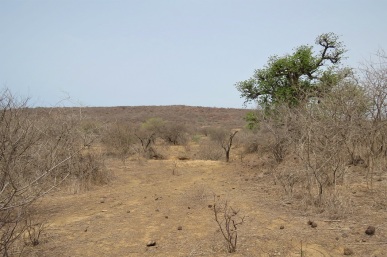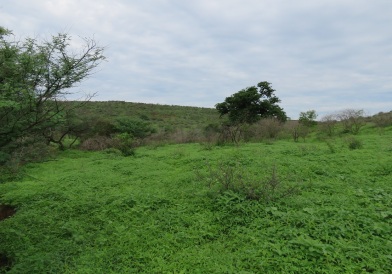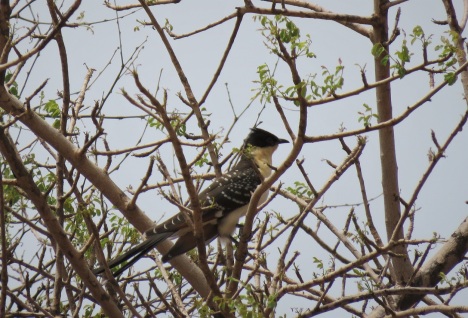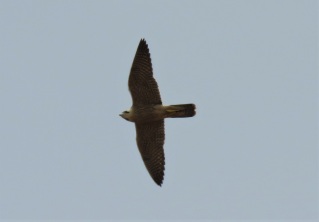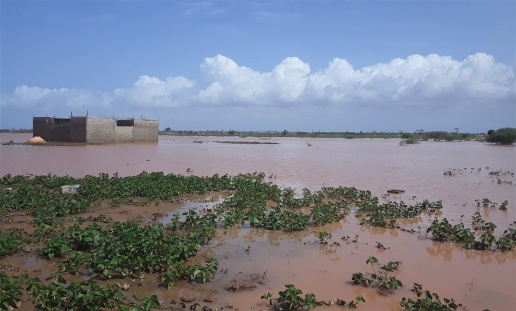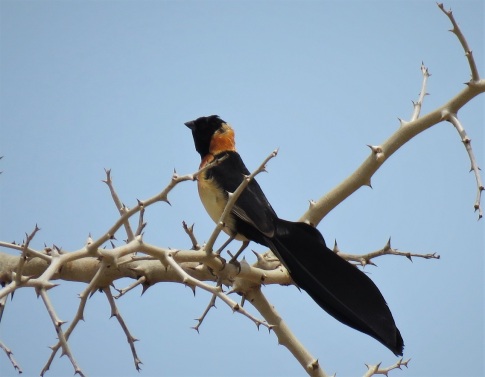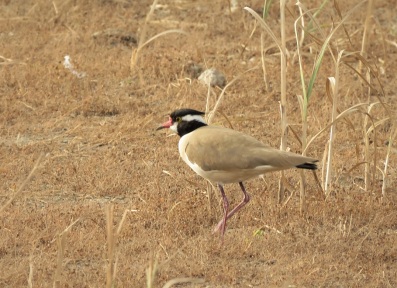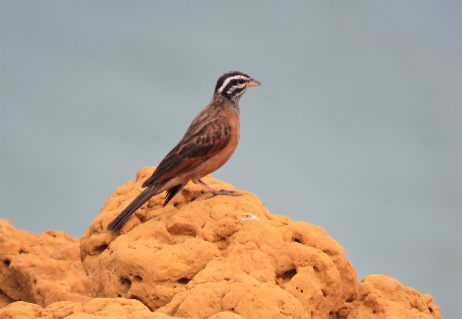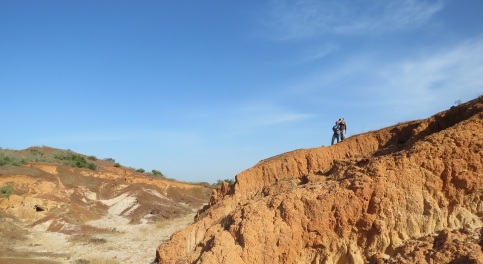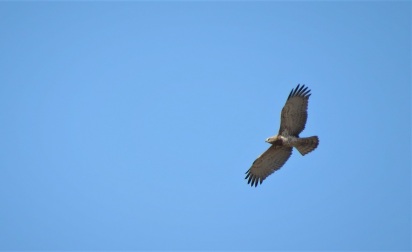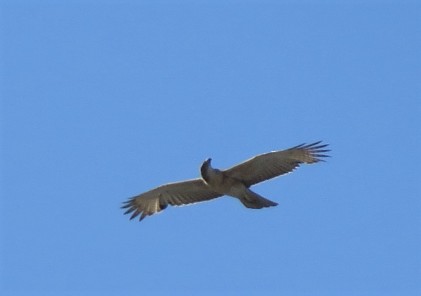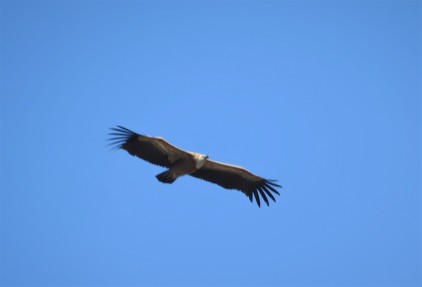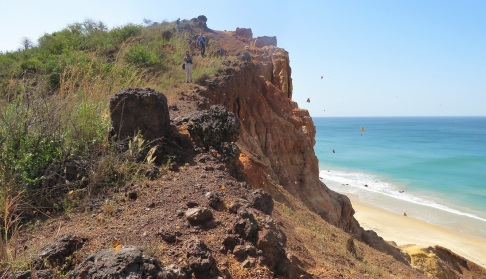Wet season visitors, Popenguine & co.
Every year during the wet season, the Sahel undergoes an impressive transformation, the landscape turning all lush green in the space of just a few weeks. Four visits to the northern Petite Côte area in just as many weeks were a nice opportunity to see this extremely rapid transition from ultra-dry to completely soaked terrain. And with it of course the associated changes in bird life.
On our first excursion to Popenguine mid-August, shortly after the onset of the first few rains, the reserve was still bone dry, only the baobabs being all green & leafy while grasses has only just begun to sprout.
Exactly one month later, this is what the same area looked like (the same baobab tree can be seen in both pictures):
Impressive, right? It never ceases to amaze me how fast everything grows here once the rains arrive!
For now, back to mid-August when all was dry, and when the highlights of our visit were a juvenile Great Spotted Cuckoo (locally hatched?)…
… a female Standard-winged Nightjar (on transit, looking for greener pastures? August is breeding season here for the species…)…
… and finally this juvenile Peregrine Falcon circling briefly above the cliffs before disappearing towards the village – an early record here, though perhaps not that surprising given that the species breeds early in the Mediterranean, even if the pair that winters in Dakar every year typically shows up around mid-October only.
Fast-forward ten days, after copious showers in the preceding days, and the lagoons of the region were now completely filled – in particular the Yene lagoon which I’ve never seen this high:
Few waterbirds were around but this will surely change in coming weeks; a Knob-billed Duck amongst the White-faced Whistling Ducks was the most notable species here (Canard à bosse, Dendrocygne veuf). Should be interesting to see how the birdlife evolves here in the next few months, and what species will show up this year (last year with the lack of rains the site was pretty disappointing, should be far more interesting this year!!).
A stroll on one of the hills above Toubab Dialaw produced several Savile’s Bustards and Singing Bush Larks, while Mottled Spinetails were flying above the small escarpment… Klaas’s and Diederik Cuckoos were heard near the village (Outarde de Savile, Alouette chanteuse, Martinet d’Ussher, Coucous de Klaas et didric).
The bustards were particularly vocal and obviously occur in good densities here, with at least 4-5 birds responding to one another. Recording here on xeno-canto; picture of habitat below. This rather sought-after Sahel special is clearly easy to find here, even if rather disturbed habitat, particularly during the rains but they may sing – albeit the shorter version of their song, and less regularly – throughout the dry season as well. They’re often difficult to spot and even a careful approach to a singing bird will usually result in just a brief glimpse, a bird flushed from low bushes, or no sighting at all… Senegal and to a lesser extent The Gambia currently remain pretty much the only easily accessible countries to find this species.
A male Sahel Paradise Whydah in full breeding plumage was encountered along the track leading to Diass:
Back to Popenguine on Sept. 8th, this time round for a very enjoyable bike tour through the bush between the villages of Popenguine, Ndayene and Toubab Dialaw (with Teranga Bike Adventure, highly recommended!) which provided a different kind of birding experience. Again Savile’s Bustard and Singing Bush Larks which are both very vocal at the moment, a Black-headed Lapwing breeding record (adult with chick), a Green Sandpiper flushed from a small pool along one of the tracks, a few Gull-billed Terns feeding over moist grassland, a Broad-billed Roller, Yellow-billed Oxpecker feeding on a donkey, a Gosling’s Bunting, and so on (Outarde de Savile, Alouette chanteuse, Vanneau à tête noire, Chevalier culblanc, Sterne hansel, Rolle violet, Piqueboeuf, Bruant d’Alexander).
Last Sunday, Popenguine nature reserve again: the usual suspects such as Rufous-tailed Scrub Robin (the resident ssp. minor, “African Scrub Robin”), Stone Partridge, Helmeted Guineafowl, Senegal Batis, several Sahel Paradise Whydahs including males in display flight and a few females, one of which was clearly interested in a pair of Green-winged Pytilias which is the host species of this brood parasite (Agrobate roux, Poulette de roche, Pintade de Numidie, Pririt du Senegal, Veuve a collier d’or, Beaumarquet melba). Woodland Kingfisher and Klaas’s Cuckoo had joined the ranks of the intra-African migrants that move north with the rains and that occur in Popenguine (Martin-chasseur du Sénégal, Coucou de Klaas).
Several Gosling’s Buntings were singing at the top of the Cap de Naze cliffs, with one bird posing quite nicely at short range:
Migrant songbirds have now started to arrive from Europe: at least three Sand Martins were flying overhead, clearly heading south, when I arrived by the pond which by now is completely filled with water; I heard a Tree Pipit, saw 4-5 migrating Barn Swallows, while the acacias and bushes held a few Melodious Warblers, Willow Warblers, a Common Whitethroat, and even a fine Nightingale. (Hirondelles de rivage et rustique, Pipit des arbres, Hippolais polyglotte, Pouillot fitis, Fauvette grisette, Rossignol philomèle).
The Popenguine eBird checklists along with other recent records from the area – including a surprising African Crake seen by Miguel – can be found here.
Plenty more to come!
Popenguine Raptor Fest (3.11.18)
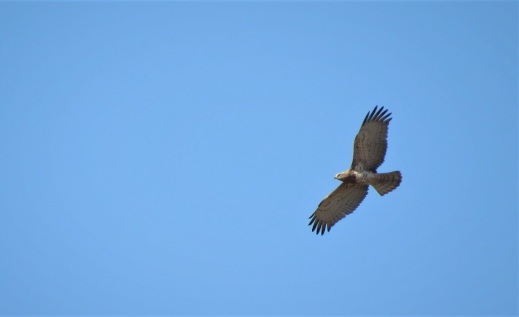
A visit to Popenguine nature reserve a couple of weeks ago quickly turned into a exciting few hours watching a good variety of raptors – something we’re not much used to in this part of Senegal, where there are few sites that are good for raptors, and most of the time anything else than a Yellow-billed Kite, Osprey or Hooded Vulture will qualify as a good record. Here’s a short overview, in order of appearance!
As always, several Ospreys were to be seen in the reserve; a few birds usually spend the night on the mighty baobabs that dot the Popenguine savanna, and all day long Ospreys can be seen flying around the cliffs or fishing out at sea. Later that same day at the lagoon just south of Toubab Dialaw, we had a good count of some 29 birds, all visible at the same time (Balbuzard). Popenguine of course also had a few Yellow-billed Kites patrolling the area (Milan à bec jaune).
As we were looking for a Common Rock Thrush we’d briefly spotted on a ridge ahead of the footpath, we noticed first an immature Peregrine Falcon flying around, then a European Hobby – the latter a scarce migrant through Senegal so always a good find. Hobby was already seen at Popenguine around the same time last year by Miguel. This time round it looked like it was an actively migrating individual, just like a Common Kestrel that briefly made an appearance shortly after (Faucons pèlerin, hobereau et crécerelle).
Next up was a Marsh Harrier circling in the distance, again probably a bird on its way to wintering grounds further south (Busard des roseaux). I’ve always thought that Popenguine would be a fairly strategic site to look for actively migrating raptors and other birds. Should be interesting to spend a few days here in October-November and February-March!
This Short-toed Eagle on the other hand was probably one of the 2-3 birds that typically spend the winter in the area around Popenguine and Guereo.
Far less expected than the previous species was an African Hawk-Eagle, spotted by Gabriel as it arrived from the north-east and made its way towards the cliffs, at one point circling together with a couple of Ospreys. Initially we weren’t quite sure about its identity and tentatively id’d this bird as a Bonelli’s Eagle, wondering whether a juvenile African Hawk-Eagle could be ruled out, and were a bit puzzled by the very pale appearance of this eagle. Luckily I managed a few record shots, a bit distant and hazy but they should do the trick. The plumage seemed to still be within the variation of worn juvenile Bonelli’s Eagle, but moult should not start until the second year and this bird shows clear moult contrast on with fresh inner primaries growing. Simon was the first to point out, after this post was originally published, that it looked more like African Hawk-Eagle. I eventually sent out the picture for comments, and Dick Forsman kindly responded, confirming that it’s an African Hawk-Eagle: “It is overall lighter below, the juvenile remiges (primaries + secondaries) are too light and too poorly barred below for a juv. Bonelli’s and the replaced inner primary shows just a dark tip without any further barring. Note also the translucent primaries in the images with blue sky, another pro-spilogaster feature.” Thanks Dick! (post updated Dec. 27)
African Hawk-Eagle is reasonable common it seems through the southern half of Senegal, and is a classic sighting e.g. in the Niokolo-Koba area. There are some records from the Saloum delta and even from the middle Senegal valley (as per Morel & Morel and Sauvage & Rodwell), but as far as I know this is the first from the Petite Côte.
I’m still hoping to see Bonelli’s Eagle one day in the Djoudj, Trois-Marigots or elsewhere in the Senegal valley, the only area with more or less regular records in winter (mainly by Frédéric, who year after year has documented the presence of a few birds around Saint Louis and who nicely summarised the current knowledge about this scarce species in West Africa, in this post on Ornithondar).
After we’d reached the top of the cliffs, next up was this Eurasian Griffon which appeared to be actively migrating along the coastline, just like a second bird we’d see a couple of hours later that same morning near Yène.
Barely a few minutes later, Gabriel strikes again with a young Lanner making a brief appearance, just as we were heading back towards the reserve entrance (Faucon lanier). That’s four species of falcons, not bad! In previous years we’ve also had Barbary Falcon near the cliffs, and surely Red-necked Falcon and Grey Kestrel must also occur at least occasionally, while in the wet season it may be possible to encounter African Hobby.
We thought we’d seen pretty much everything when at the last minute a Shikra was seen dashing over the pond (all but dry!), bringing our morning’s total to 11 birds of prey.
Besides all these hooked beaks, as always the nature reserve held quite a few other good bird, such as Gosling’s Bunting, Green-winged Pytillia, Sahel Paradise-Whydah, Blue Rock Thrush, and Northern Anteater Chat. In the end we saw two different Common (=Rufous-tailed) Rock Thrushes, a scarce migrant in Senegal, see this post on our first encounter with the species, in February 2016 at… Popenguine! Also a decent flock of Pallid Swifts and a few White-throated Bee-eaters, both pretty good bonus species, while two Pygmy Kingfishers including at least one dark-billed juvenile provided proof that the species is breeding here.
Complete eBird checklist available here.
The bird list for the Popenguine reserve now stands at some 198 species, at a minimum that is: I listed more than 20 other species as being most likely present, but which apparently remain to be confirmed. More on that over here.
Oh and then there were the butterflies – pure magic! Thousands and thousands of butterflies everywhere, especially along the track up the cliffs. With every footstep, small clouds of butterflies would explode, while a constant stream of butterflies was passing by the cliffs. Our visit clearly took place during peak migration season of Painted Lady which were the vast majority, and to a lesser extent some pieridae. And loads of dragonflies! Difficult to capture on camera but if you look carefully at the image below you’ll get a bit of a sense of what I’m trying to explain here.
Peregrine Falcon on Hotel Ngor Diarama.
A Peregrine Falcon, the world’s fastest bird of prey, has for years spent the winter months on Hotel Ngor Diarama. Peregrines normally breed on and hunt from cliff faces and the architecture of Hotel Ngor Diarama obviously resembles a cliff face. I have been looking for the Peregrine for the last couple of months and now (s)he has finally returned. (S)he makes dashing flights from the hotel around the Ngor area on long broad-based pointed wings, like elegant triangles. I can only recommend everyone to pass by Hotel Ngor Diarama and enjoy the flight of this fantastic bird.
Flemming.

